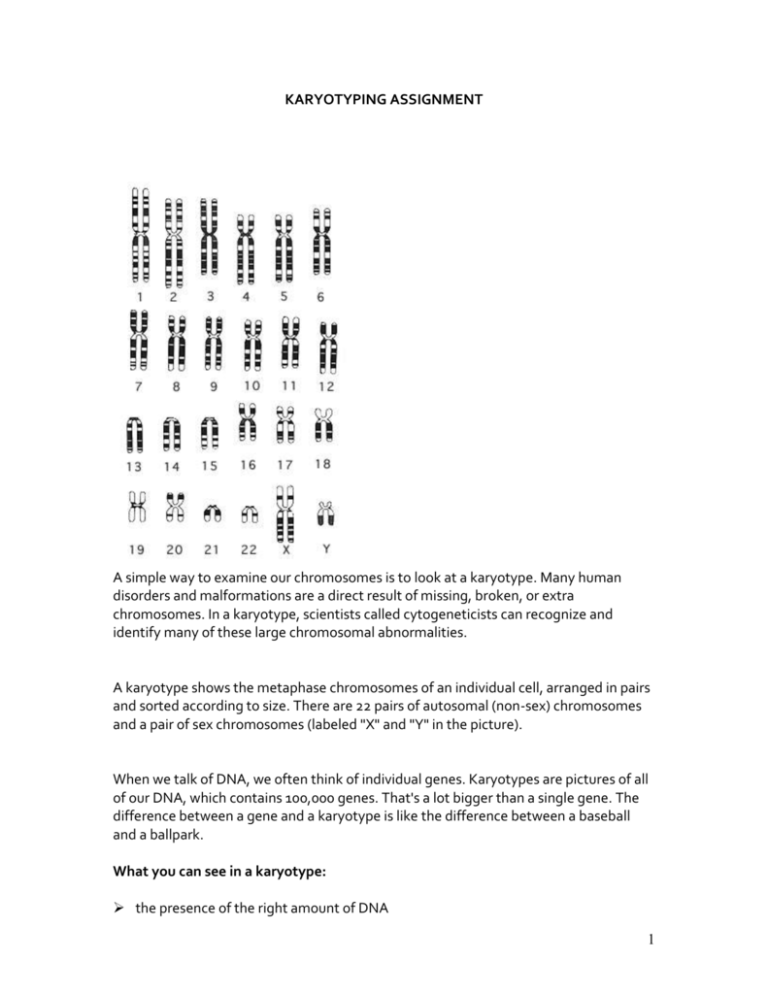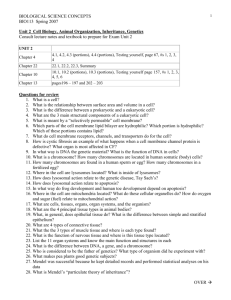What can our chromosomes tell us
advertisement

KARYOTYPING ASSIGNMENT A simple way to examine our chromosomes is to look at a karyotype. Many human disorders and malformations are a direct result of missing, broken, or extra chromosomes. In a karyotype, scientists called cytogeneticists can recognize and identify many of these large chromosomal abnormalities. A karyotype shows the metaphase chromosomes of an individual cell, arranged in pairs and sorted according to size. There are 22 pairs of autosomal (non-sex) chromosomes and a pair of sex chromosomes (labeled "X" and "Y" in the picture). When we talk of DNA, we often think of individual genes. Karyotypes are pictures of all of our DNA, which contains 100,000 genes. That's a lot bigger than a single gene. The difference between a gene and a karyotype is like the difference between a baseball and a ballpark. What you can see in a karyotype: the presence of the right amount of DNA 1 the presence of the right content of DNA the sex of the individual certain infertility problems of the individual What you can't see in a karyotype: presence and location of small mutations in genes can't identify the type of mutation present How do they know which chromosomes go together? The first way is to sort them according to size. Some chromosomes are much longer than others are, as you can see in the picture above. Second, the position of the centromere relative to the end of the chromosome is used to help tell chromosomes apart. Centromeres are designated either metacentric, submetacentric, or acrocentric (see picture). Metacentric chromosomes have their centromere near the center of the chromosome. Submetacentric chromosomes have slightly off-center centromeres, such that one chromosome arm is longer than the other. Acrocentric chromosomes have the centromere located very near to one end. A third way is to stain them with chemical dyes. Staining results in patterns of bands that are characteristic for each chromosome pair. What does a karyotype's name mean? Karyotype names include information about: the number of chromosomes per cell the composition of the sex chromosomes identification of any chromosomal abnormalities For example, "46, XX" designates a normal female karyotype. 46 is the normal number of chromosomes. The two XX's indicate the normal composition of sex chromosomes for a female. "47, XXY" indicates a male karyotype with an extra chromosome, in this case an extra sex chromosome. "47, XX, +21" indicates a female individual with normal sex chromosomes who has an extra chromosome 21. What happens if our chromosomes are abnormal? We are supposed to have 46 total chromosomes in each cell (22 pairs = 44, + 2 sex chromosomes). What if we have: mixed up pieces of chromosomes? 2 too many / too few chromosomes? 46 chromosomes? missing pieces of chromosomes? Activity: 1. Go to the following web site. http://www.biology.arizona.edu/human_bio/activities/karyotyping/karyotyping.ht ml 2. Complete the karyotyping assignment for the three patients and answer the questions about abnormalities. 3. Do NOT do the Internet research from that site. Go to this site: http://vector.cshl.org/dnaftb/10/concept/ Search one of the topics on the right. * Property of AMHS, modified 2014 3








